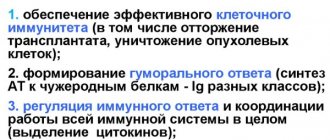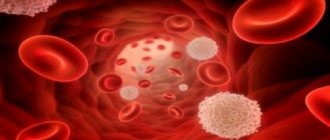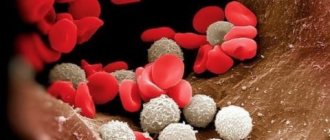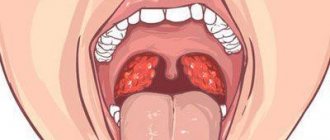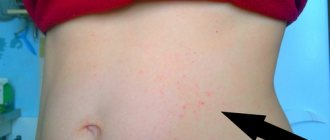0
Author of the article: Marina Dmitrievna
2017.08.02
608
Platelets
Platelets are small, flattened, disc-shaped blood cells without a nucleus. Their deficiency or excess in the body negatively affects the patient’s health, which is especially noticeable at a younger age. Thrombocytopenia is a disease that causes a lack of platelets in the blood of children. Read more about what this is and what parents should do in such a situation later in the article.
Platelets
What platelet level is considered low?
The optimal level of these blood cells is 150-400 *109/l. If this indicator drops below 150*109/l, the patient is diagnosed with thrombocytopenia, due to which the blood stops clotting.
Thrombocytopenia can be a separate disease or a sign of various diseases. To accurately establish the cause of its development and select appropriate therapy, the patient is sent for additional examination.
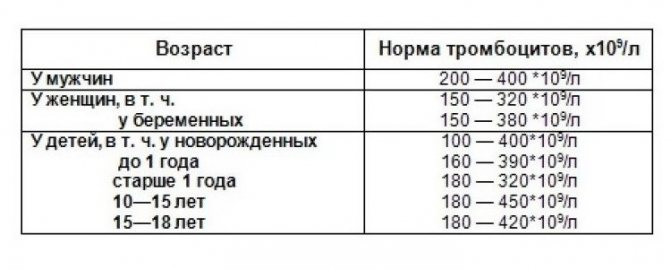
Norms
What is the normal cell count for children?
The number of platelets is determined in capillary blood , that is, by donating blood from a finger.
The platelet count is defined as 109/L or G/L (giga per liter). The normal platelet count practically does not depend on the age and gender of the child and on average is 150-300 per 10 (or 150-300 G/l).
There is another way to determine platelets when they are listed per 1000 red blood cells. In this case, normative figures will be 60-100‰. The platelet count is relatively variable.
Blood cell levels can vary throughout the day and throughout the year. It also depends on the composition of the food that the child took and the tone of the blood vessels. In addition, platelet levels typically increase after exercise.
The main pathological disorders of platelet count are: thrombocytosis; thrombocytopenia.
Causes of thrombocytopenia
Short-term thrombocytopenia may occur due to:
- monthly bleeding;
- pregnancy;
- vitamin deficiency;
- taking antidepressants, hormones and antibiotics);
- alcohol and chemical poisoning;
- surgical intervention;
- severe injuries;
- abuse of garlic, onions, cherries, lemon and ginger;
- vitamin B12 deficiency.

Severe platelet deviation occurs when:
- tuberculosis;
- leukemia;
- hepatitis;
- HIV;
- aplastic anemia;
- liver cirrhosis;
- rheumatoid arthritis;
- herpes;
- heart failure;
- mononucleosis;
- measles;
- allergies;
- ARVI and acute respiratory infections;
- DIC syndrome.
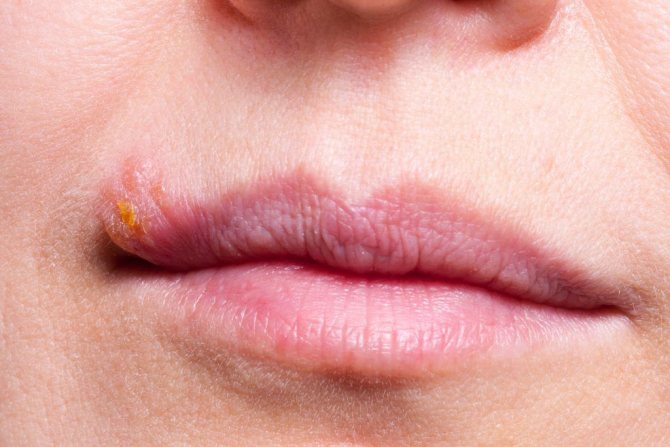
Herpes
Platelets are below normal: what is the danger?
If, after the next blood test, it turns out that the child has fewer platelets than he should have at his age, this is a reason to sound the alarm.
Platelets are responsible for blood clotting. The list of their functions includes:
- release of special substances that accelerate the healing of damaged tissues;
- blockage of damaged vessel sites to stop bleeding;
- delivery of nutrients to the vascular endothelium.
When there are few such cells, the blood becomes more fluid and wound healing slows down.
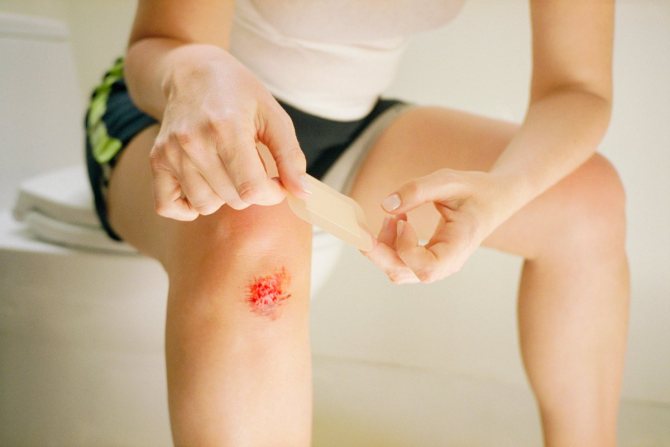
Poor healing
Severity, symptoms
There are several forms of thrombocytopenia:
- mild - if the readings are within 75-99 × 10⁹/l;
- moderate – 50-74 × 10⁹/l;
- average 20-49 × 10⁹/l;
- heavy – 20 × 10⁹/l.
Low platelets in a child at the first or second stage can only be detected through blood donation. Often this condition does not produce any symptoms. This is especially true for babies who cannot tell about their well-being.
Among the external signs one can note:
- frequent nosebleeds;
- bleeding gums;
- rashes all over the body;
- urine mixed with blood;
- causeless bruising;
- vomiting blood.
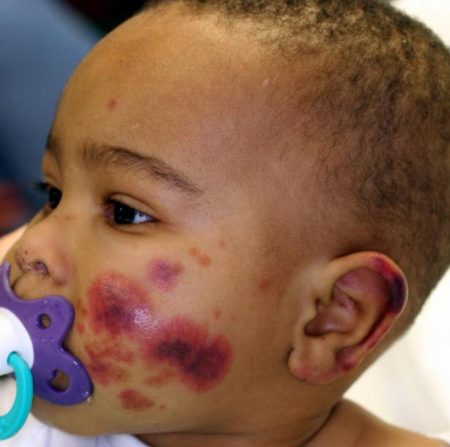
A decrease in platelet count leads to undesirable consequences:
- prolonged wound healing;
- bruises even from light touches;
- relatively large loss of blood from scratches;
- hemorrhages from the gastrointestinal tract;
- in girls during puberty - uterine bleeding.
As you can see, these are quite dangerous complications. Failure to see a doctor in a timely manner can have a negative impact on the child’s well-being.
If at least one of the above symptoms develops, parents urgently need to show their child to a doctor.
Important! Before visiting a doctor, remember all the factors that could provoke the manifestation of the symptom.
The slightest detail is enough to suggest the correct reason the first time. Knowing it, it will be easier for the doctor to create a treatment plan.
What to do
If low platelets are detected in a child, with a slight deviation from the norm, it is necessary to make changes to the diet, supplementing the diet with iron-containing foods, vitamins C and A. Increase the diet with foods such as buckwheat, meat, fish, herbs, and vegetables. You should avoid fruit juices, and you should also remove seaweed and cranberries from your diet.
It is necessary to control the daily routine, the child must sleep a sufficient amount of time and maintain moderate physical activity, be in the fresh air more often, and relax with his parents in nature.
If a child has low platelets, it is allowed to use traditional medicine in the form of herbal infusions, but only after mandatory consultation with a pediatrician. In the moderate and severe stages of falling particles, in addition to proper nutrition, drug treatment is necessary, which will consist of eliminating the main cause of the pathology that has arisen. Medicines and other methods of therapy should be selected by a pediatrician.
Important information: What do low leukocytes and high lymphocytes indicate in a blood test?
The following drugs are used:
- A group of corticosteroids - are involved in the process of regulating the formation of cells in the bone marrow in sufficient quantities. It is important to use this group of medications correctly to avoid side effects. In case of severe pathology of the liver and kidneys, use is contraindicated.
- Immunoglobulins - used in injections if the reason for the reduced level of particles is an inflammatory process. With this therapy, not only does the number of blood cells increase, but their life period also extends, and local and general immunity is strengthened.
- Preparations in the form of serums that slow down the process of platelet destruction. If the amount drops to a critical level, and drug therapy is not effective, a transfusion is performed using donor blood.
- In case of pathology in newborns up to three months of age, special milk and dairy-free formulas are selected, and, if necessary, drug treatment or blood transfusions are also prescribed.
Why are platelets low in a child?
Most often, a strong decrease in the number of blood platelets is caused by thrombocytopenic purpura - an independent disease that manifests itself more often in the period from 2 to 6 years. Other causes of thrombocytopenia in childhood:
- infectious diseases (measles, rubella);
- autoimmune reactions of the body;
- heavy metal vapor poisoning;
- oncohematological diseases.
Purpura can be diagnosed even in a newborn. To minimize the consequences, you should immediately consult a doctor. He will compare platelet standards for children and the data obtained and, if the platelet count has really dropped, prescribe tests and treatment.
The norm depends on age:
- in a newborn – 100-420 × 10⁹/l;
- in infants (up to one year) – 150-350 × 10⁹/l;
- after a year – 180-320 × 10⁹/l.
Obviously, a reading of 70 × 10⁹/L means a low platelet count in a child and requires close monitoring of health.

One of the reasons
Analysis and normal values
Platelet cell levels in childhood may be higher or lower than normal depending on many factors. This may be the general condition of the body, the nature of nutrition, or taking medications. But the main criterion for determining a normal platelet count is the child’s age.
Normal platelet count:
- newborns 1-4 days after birth - 100-410 billion/l;
- 8-11 days - 160-400 billion/l;
- 4 weeks - 165-410 billion/l;
- infants up to 6 months - 185-400 billion/l;
- 1 year - 160-380 billion/l;
- 1-4 years - 160-450 billion/l;
- 5-7 years - 180-450 billion/l;
- 7 years and older - 180-460 billion/l.
Children who are healthy should have a blood test at least once a year. If there is a predisposition in terms of hereditary pathology, which is associated with deviations in platelet levels, monitoring should be carried out 3-5 times a year, and in case of bone marrow diseases, more frequent blood tests are recommended.
To determine the level of platelets in the blood as accurately as possible, you must follow these rules:
- a few days before donating blood, reduce physical activity in children;
- The test is taken on an empty stomach, in the morning, 1.5-2 hours after sleep;
- Drinking before the procedure is not allowed.
Important information: What does low red blood cells mean in the blood of an adult (causes in women)
Diagnosis and treatment
To identify pathology, you need to donate blood. It is possible to take it from a finger or vein, and in the case of infants, from the heel. To rule out that the platelets in the child’s blood have decreased temporarily (a reaction to stress or illness), blood samples are taken several times with an interval of 3-5 days.
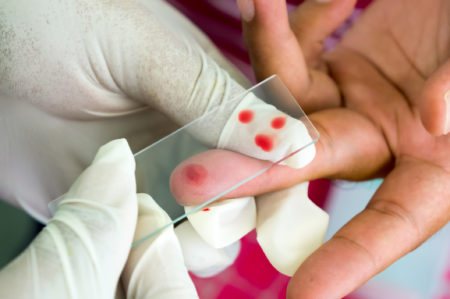
Taking blood from your finger is a quick way to find out your platelet count
Important! In teenage girls, a decrease in the number of blood platelets is allowed. This is due to the formation of the menstrual cycle.
Since other diseases can lower platelet levels, they are treated first, and only then do they look at the situation. If complications still exist and thrombocytopenia has not disappeared, a number of medications are prescribed. The list of activities may include:
- immunoglobulin injections;
- taking hormonal drugs and cytostatics;
- introduction of special hemostatic drugs;
- platelet transfusion.
Let us consider in more detail the various methods of treating thrombocytopenia.
Medication
It involves the use of drugs that block antibodies that destroy platelets and inhibit their synthesis. Such medications include:
- Prednisolone. A tableted medication that stops the formation of antibodies in the spleen, protects platelets from destruction and strengthens capillary walls. Minimum price – 120 rubles.
- Intraglobin. The medication has a positive effect on the immune system, destroys antibodies and prevents them from contacting platelets, and kills viral cells. The cost of the medicine is 135-170 rubles.
- Vincristine. Injection powder prevents the formation of pathogenic cells and blocks the synthesis of antibodies in the spleen. You will have to pay 155-210 rubles for the medicine.
To improve the therapeutic effect of medications, you need to follow a certain diet.

Vincristine
Diet
The basics of therapeutic nutrition for thrombocytopenia are equally suitable for adult and young patients.
The patient's diet should be based on:
- buckwheat;
- nuts;
- corn;
- beef liver;
- barley groats;
- oatmeal;
- sprouted wheat;
- spinach;
- parsley;
- dill;
- asparagus;
- green onions;
- freshly prepared vegetable and fruit juices.

It is useful for a child to eat:
- melon;
- apricots;
- legumes;
- pumpkin;
- avocado.
A small patient's diet should not include fast food, spicy, fried, smoked or salty foods.
Traditional methods
Thrombocytopenia is well eliminated:
- Infusion of medicinal verbena. The drink saturates the body with iron and improves blood circulation.
- Sesame oil. The substance stabilizes platelet levels and improves blood clotting.
- Infusion of stinging nettle. Stops bleeding and stimulates wound healing.

Sesame seed oil
Treatment of newborns
Therapy for newborn babies involves the use of:
- donor milk for 14-21 days, then, under constant monitoring of platelet levels, mother’s milk can be given;
- immunoglobulin intravenously or as infusions;
- prednisolone at a dose of 2 mg per 1 kilogram for 14 days;
- ascorbic acid and rutin;
- platelet transfusions.
Important! In severe forms, you need to be prepared for the fact that the spleen will need to be removed.
Such surgical intervention is completely justified if the low level of platelets in the child’s blood is not regulated to the required extent with the help of medications.
In severe stages, bed rest is prescribed. It is recommended to eat more nuts, bananas and pomegranates - in a healthy body they naturally provoke an increased production of blood platelets.
If a child’s platelets are severely or moderately low, it makes sense to give him only warm food - this will have a positive effect on the gastrointestinal mucosa and reduce the risk of bleeding.



